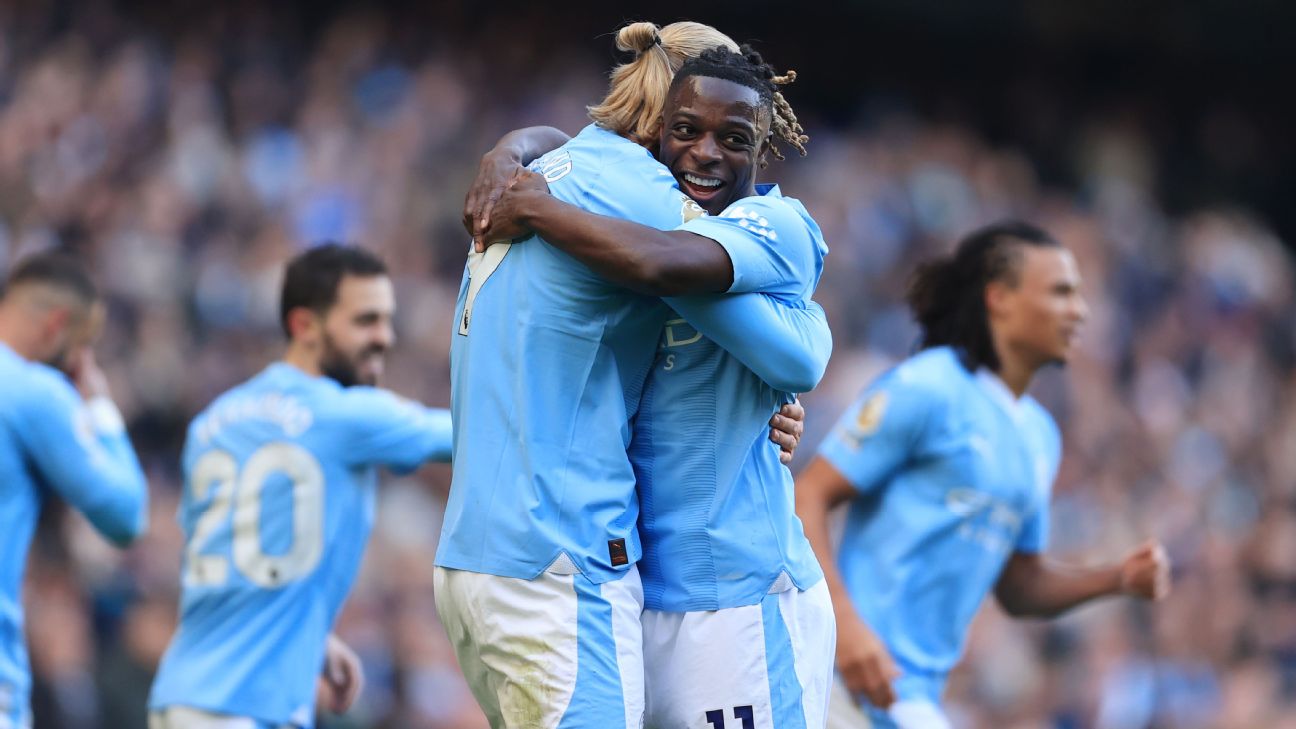Right around now, everyone in and around the NFL begins to argue about the semantics of a single word: “value.” What does it really mean to be the “most valuable player” in the National Football League? By definition, can it only be a quarterback because a quarterback is the only player who touches the ball on every offensive play? Or should it go to a receiver or running back or defensive player who is much better than his positional peers than the best quarterback — even if, by definition, someone in one of those positions simply can’t provide as much value as the guy behind center?
In soccer, we sort of tiptoe around this idea by never really getting into the MVP debate. Instead, the awards go to the “player of the year” or the “most outstanding player.” Outside of the Ballon d’Or, individual awards don’t really carry much weight across the historical narratives of the sport anyway.
On top of that, we’re sort of stuck in two phases with our understanding of how the sport works anyway. Either we don’t know enough about how soccer works yet to really even attempt to define value or, like in football, the most valuable players are always going to be the ones who create or score the points.
However, while the goal of soccer is to, uh, score more goals than the other team, there’s a sub-goal inherent to that idea: moving the ball into more dangerous goal-scoring areas more often than the other team.
Throughout the course of a match, Stats Perform constantly calculates the likelihood that a goal will be scored within the next 10 seconds of a given possession based on where the ball is on the field. And by doing that, they award and penalize players who are undertaking actions that increase, or decrease, those likelihoods of a goal being scored. If you have the ball in an area where there’s a 1% chance of a goal being scored and you play it to an area where there’s a 15% chance of a goal being scored, you’re awarded with the 14% change.
It’s called Expected Possession Value, and the numbers represent the combined increase in goal-scoring probability created by each player. That stat isn’t a catch-all value metric like baseball’s wins above replacement, but it calculates how valuable each player is in buildup play. So, we’re going to use it to identify the MVPPs (most valuable possession players) for all 20 teams in the Premier League through 14 matches, ranked in order of MVP.
 BRENTFORD: Bryan Mbeumo
BRENTFORD: Bryan Mbeumo
– Position: forward
– Age: 24
– EPV: 4.60
Much of the total EPV generated by a player is an echo of his team’s tactics and his teammates. We’re listing all the players in the piece, in descending order, by how much value they’ve created in possession, but that’s just a way to organize the piece — not to rank players. EPV is much more useful to use the stat to compare players who play for the same team, which is why we’re awarding one MVPP per team.
Before the season, I picked six potential breakout players in the Premier League. We’re going to completely ignore that Manchester United’s Jadon Sancho was one of them and instead focus on the presence of Mbeumo on the list.
With star striker Ivan Toney still suspended, I predicted that Mbeumo would both improve as he entered his prime years and be given a bigger workload with Toney out. Both of those predictions turned out to be right.
Owned by professional sports bettor Matthew Benham, Brentford play in a way that almost seems designed to boost their EPV output. What these EPV models tend to reveal about how soccer works is that nothing that happens in the middle third can significantly change your likelihood of scoring or conceding a goal. They also show that incomplete passes can be valuable if they’re played into a high-value area like the penalty area.
Brentford’s style prioritizes quick movement upfield and a constant barrage of well-designed set pieces that always drive the ball into the box. (For example: They’ve added 1.3 EPV from throw-ins, while no one else is above 0.95.) As such, Mbeumo ranks second in the league in EPV generated from set-piece passes and fifth in open-play passes.
Don Hutchison believes Arsenal have rediscovered their attacking prowess after their 2-1 win over Wolves.
 ARSENAL: Bukayo Saka
ARSENAL: Bukayo Saka
– Position: winger
– Age: 22
– EPV: 4.59
While he’s still a couple of years away from his prime, Saka has never really put up gaudy and efficient attacking numbers. He broke double-digits in both goals and assists last season, but his per-90 rate (0.65 non-penalty goals+assists) ranked 14th in the league among players who featured in at least half of their team’s minutes.
This year, he’s scoring and assisting at almost exactly the same rate, but that misses a good chunk of the value he provides. Saka has increased his team’s goal-scoring probability by at least 5% a full 51 times so far this season; no other player has done so more than 41 times.
Here’s a heat map of all of those touches so far this season:
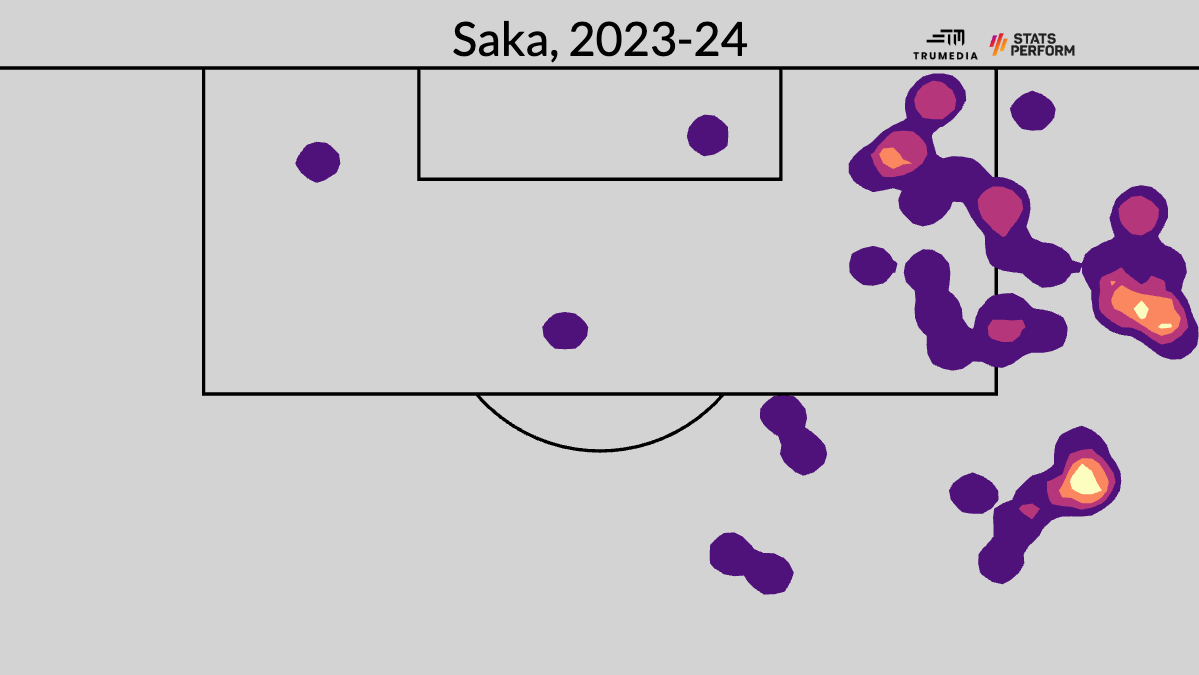
This image highlights perhaps the signature movement of any Arsenal game over the last two seasons: Saka getting on the ball deep in the opposition final third, checking back onto his left foot, and then moving the ball into the penalty area. On top of that, he’s also created the most EPV (0.52) from tackles, interceptions, and blocked passes. If he ever takes a leap into that 0.75 goals+assists-per-range, he’ll easily be one of the best players in the world.
 MANCHESTER CITY: Jérémy Doku
MANCHESTER CITY: Jérémy Doku
– Position: winger
– Age: 21
– EPV: 4.50
Doku has only played 692 minutes so far this season. Saka is at 1,126, and Mbeumo has played 1,248. On a per-minute basis, Doku has probably been the most impactful player in the Premier League.
Without EPV, I might look at Doku’s shot-creation numbers and see another inefficient, high-touch winger. He’s registering 0.42 non-penalty expected goals and assists per 90 minutes so far this season, which ranks 48th in the Premier League. But what that ignores is that basically any time Doku receives the ball within 40 yards of the opposition goal, it’s all but guaranteed to end up inside the penalty area.
Despite barely featuring in half of City’s available minutes, Doku still leads all PL players with 37 ball carries that eventually increased the team’s likelihood of scoring by 5% or more:

Doku highlights the true value of an electric dribbler. It’s not even that he constantly beats his defenders, which he does. But rather, defenders are so scared of Doku that they’ll constantly backpedal and allow just him to dribble into the box, and they’ll also play so far off of him that he can easily drive forward and then play a pass into a dangerous area. No one would confuse him with a world-class creator, and yet he leads all players in EPV created from open-play passes, too.
 BRIGHTON & HOVE ALBION: Kaoru Mitoma
BRIGHTON & HOVE ALBION: Kaoru Mitoma
– Position: winger
– Age: 26
– EPV: 4.13
Take that exact-same paragraph from the end of the Doku section, replace “Doku” with “Mitoma” and, well, my work here is nearly done.
Mitoma is so good at getting on the ball in advanced areas and then creating space with his ability to carry the ball that he’s leading the league in passes attempted that increased Brighton’s probability of scoring by at least 5%:
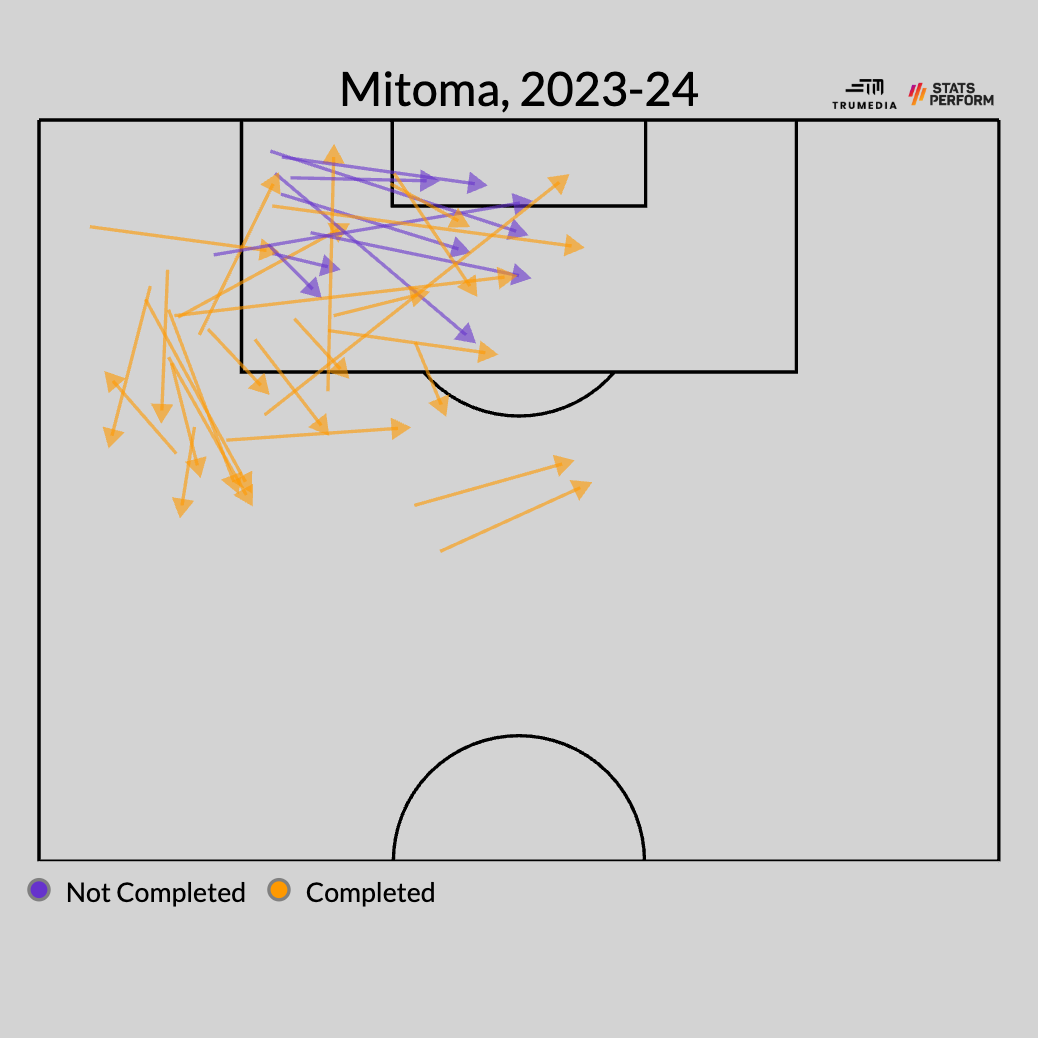
Unlike their fellow data-driven mid-table competitors Brentford, who seem to be attempting to maximize their EPV with every pass, Brighton gradually build their goal-scoring capacity with incremental movement forward. Mitoma, then, is the one who frequently turns their possession dominance into actual danger.
 MANCHESTER UNITED: Bruno Fernandes
MANCHESTER UNITED: Bruno Fernandes
– Position: attacking midfielder
– Age: 29
– EPV: 3.96
If Brentford are the team that maximizes EPV, then Bruno Fernandes is the player that does it.
One way to think about all of this is that there are generally two types of possession players: ones who attempt a low number of high value actions and ones who attempt a high number of low-value actions. Midfielders would generally fall into the latter camp, while attackers get lumped into the former.
And then you’ve got Bruno, who attempts a high number of high-value actions. Among all attacking midfielders and wingers across Europe’s Big Five leagues, he’s in the 94th percentile for passes attempted, the 99th percentile for progressive passes … and the 31st percentile for pass-completion percentage.
There are some reasonable questions about the ceiling of a team with a high-touch player who’s constantly turning the ball over, but these have never been questions United have ever been good enough to ask. He’s the club’s only truly successful signing over the past half-decade, and it’s scary to think of where they might be without him driving the ball into dangerous areas.
 NEWCASTLE UNITED: Kieran Trippier
NEWCASTLE UNITED: Kieran Trippier
– Position: fullback
– Age: 33
– EPV: 3.55
As you may have noticed, everyone else on this list plays in advanced roles. Their starting positions are positions from which it’s a lot easier to access the most valuable area on the field: the penalty area.
Kieran Trippier, however, is a traditional fullback in a back four. A good deal of the value he provides comes from his excellent set-piece delivery, but he still ranks 10th among all players in the league with 2.73 EPV created from open-play. For Trippier, a player who derives a good chunk of his value from a number of lower-value passes, it’s more instructive to look at all of his open-play passes that increased Newcastle’s likelihood of scoring by at least 1%:

Long switches, vertical balls down the line, and square passes into the heart of the penalty area — that’s how Trippier is driving possession for one of the best teams in the league.
 LIVERPOOL: Mohamed Salah
LIVERPOOL: Mohamed Salah
– Position: forward
– Age: 31
– EPV: 3.24
On one hand, Mo Salah has clearly begun to decline. These are his non-penalty xG rates for every season in the Premier League:
-
2017-18: 0.70
-
2018-19: 0.49
-
2019-20: 0.52
-
2020-21: 0.43
-
2021-22: 0.58
-
2022-23: 0.51
-
2023-24: 0.48
He’s attempting 2.65 shots per 90 minutes this season, by far the lowest of his Liverpool career and well below his average of 3.78 per 90 since joining the club.
On the other hand, Salah is averaging 0.44 expected goals assisted per 90 minutes — by far the best number of his Liverpool career. Taken together, Salah is averaging 0.92 xG+xA per 90 minutes, just slightly below the rate he produced (0.93) in his first season with the club, when he, you know, scored 31 non-penalty goals and added 10 more assists. While perhaps he’s lost some of the physical capacity to get into the box and score as many goals as he used to, he’s made up for it by becoming a devastating creative passer from the right wing.
Janusz Michallik analyses Liverpool’s performance in their breathtaking 4-3 comeback win vs. Fulham.
 ASTON VILLA: John McGinn
ASTON VILLA: John McGinn
– Position: midfielder
– Age: 29
– EPV: 3.07
Although he’s the least heralded midfielder on the team after the mid-20’s pair of France and Brazil internationals Boubacar Kamara and Douglas Luiz, McGinn has been a much more effective possession player than either of them.
Among players with at least 300 minutes of game time for Villa this season, 10 of them have attempted more passes than McGinn. It doesn’t always look pretty; in fact, it often looks pretty stilted and hurried and panicked. But despite his lack of elegance or overall time in possession, McGinn is the Villa player who most often moves the ball into dangerous areas in the final third.
These are all of his passes that increased their chance of scoring by at least 1%:
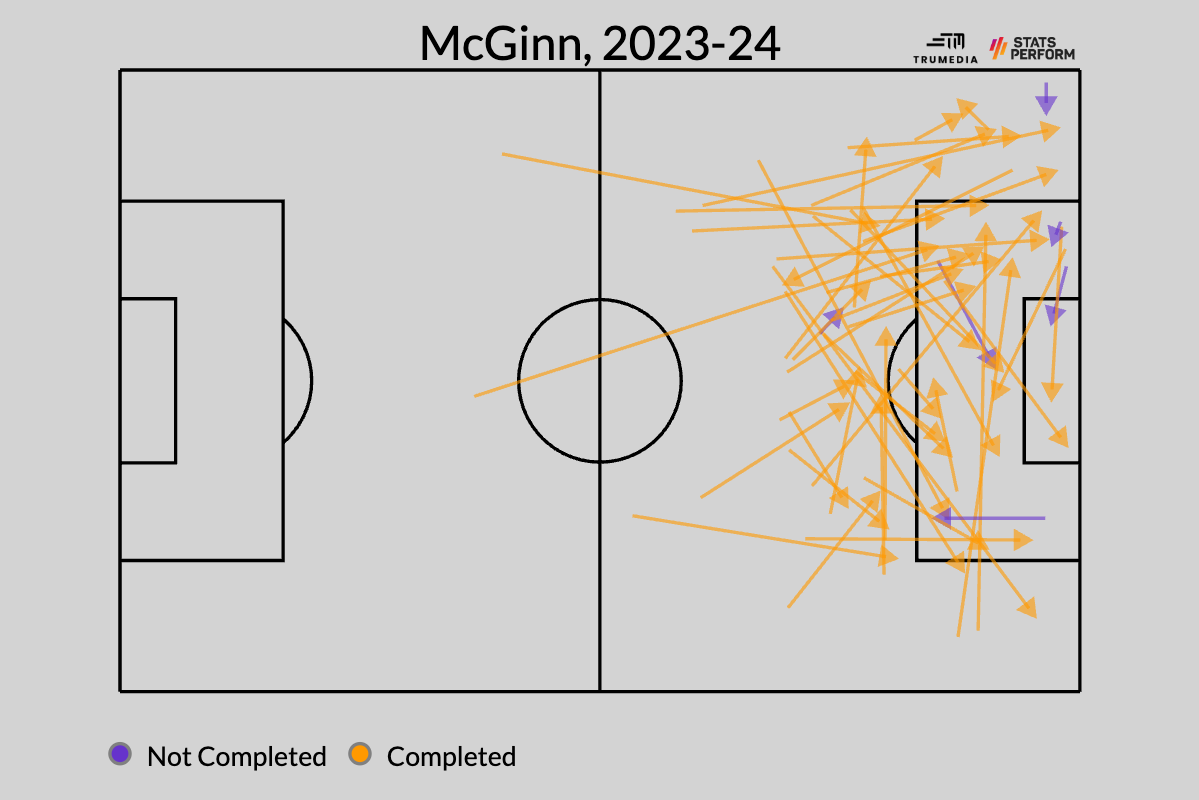
I doubt many opponents head into matches against Villa thinking, “We need to stop John McGinn,” but what this column presupposes is … maybe they should?
 CHELSEA: Raheem Sterling
CHELSEA: Raheem Sterling
– Position: winger
– Age: 28
– EPV: 2.89
Sterling’s days as a world-class wide attacker appear numbered. In his final five seasons at Manchester City, he averaged 0.72 xG+xA per 90. Last year, his first with Chelsea, he dipped down to 0.51, and this season, he’s fallen off even further, to 0.43.
However, he’s partially making up for the decline in shot production by doing something he wasn’t really needed for at City: moving the ball into dangerous areas. While at City, Sterling was a master at breaking into the penalty area and receiving the ball in the box, he’s turned that inside out at Stamford Bridge. This season, he’s averaging 6.2 progressive carries; he was never above 5.1 in any of the past six seasons. And he’s carrying the ball into the penalty area 3.4 times per match, too, a significantly higher rate than in any of the past six seasons.
Only Doku has completed more carries that eventually increased his team’s goal-scoring probability by at least 5% more often than Sterling’s 28.
 WEST HAM UNITED: Lucas Paquetá
WEST HAM UNITED: Lucas Paquetá
– Position: attacking midfielder
– Age: 26
– EPV: 2.86
Such is the effectiveness of Paquetá’s passing that he has even exceeded the value created by James Ward-Prowse, who leads the Premier League in EPV created (1.39) from corners and free kicks.
One archetype of player that emerges from this kind of analysis is the “connector.” It’s how I would describe McGinn, too. These aren’t No. 10s, who are playing seeing-eye through balls. And they’re not Toni Kroos-types, playing upwards of 100 passes in a game and maybe misplacing only one or two. Instead, they’re just playing a lot of passes that increase their team’s likelihood of scoring by 1%, like all of these:
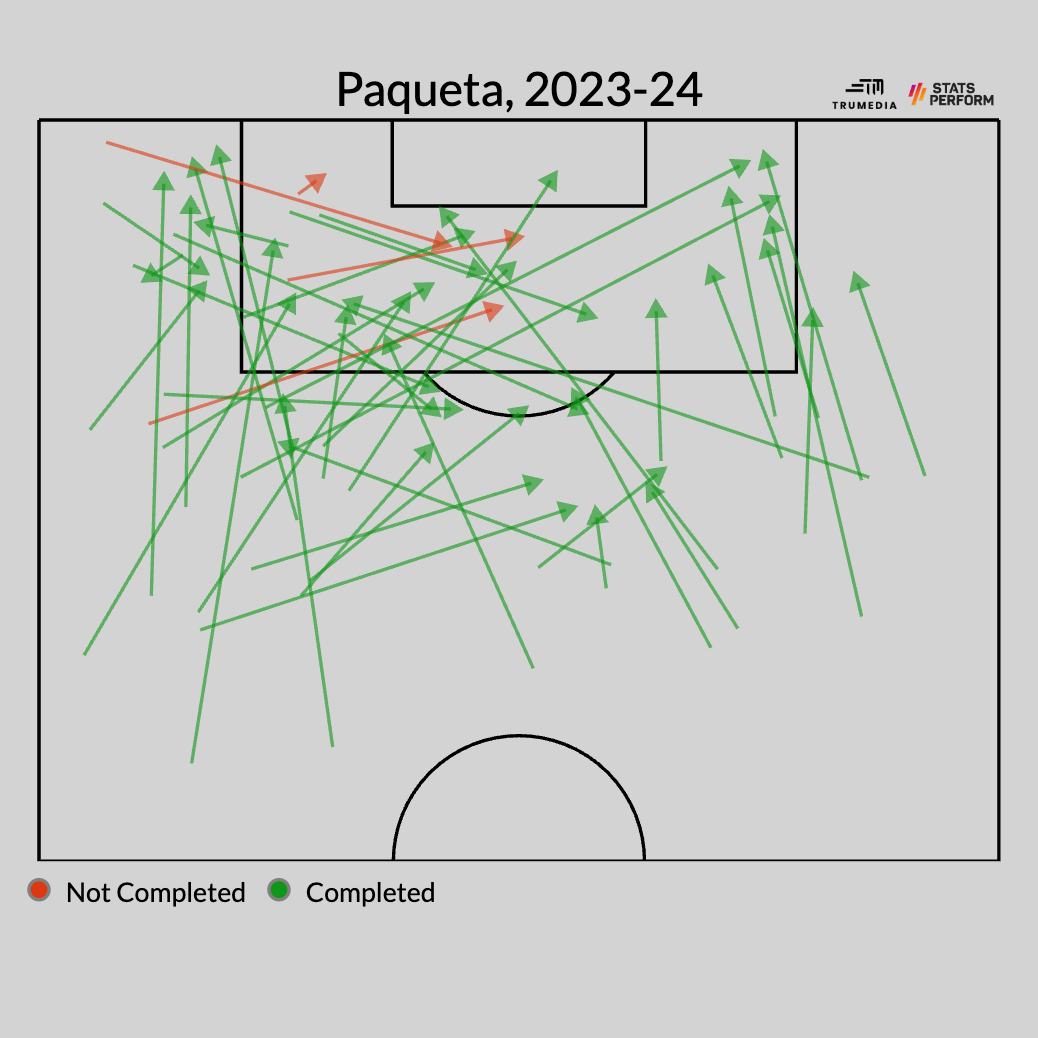
One percent might not seem like a lot, but think of it this way: Paquetá plays 3.4 of these passes per 90 minutes. If each one is worth 1/100th of a goal, that adds up to about 1.3 extra goals per season. Given the value of each additional goal in the Premier League, that, alone, is worth more than $1 million.
 TOTTENHAM: Dejan Kulusevski
TOTTENHAM: Dejan Kulusevski
– Position: attacking midfielder
– Age: 23
– EPV: 2.69
Had he not gotten injured, this would be James Maddison’s place. In fact, Maddison would be way higher up this list were he still healthy. He’s just 0.02 points of EPV behind Kulusevski despite not playing since Tottenham’s 4-1 loss to Chelsea.
In my mind, almost all of Kulusevski’s valuable passes come from him doing one of two things: (1) cutting in from the right, then playing a ball to the right side of a defender (or defenders) as a teammate darts diagonally into the box in the opposite direction, (2) cutting in from the right, then standing a ball up to the back post for some weak-side attacker to run onto.
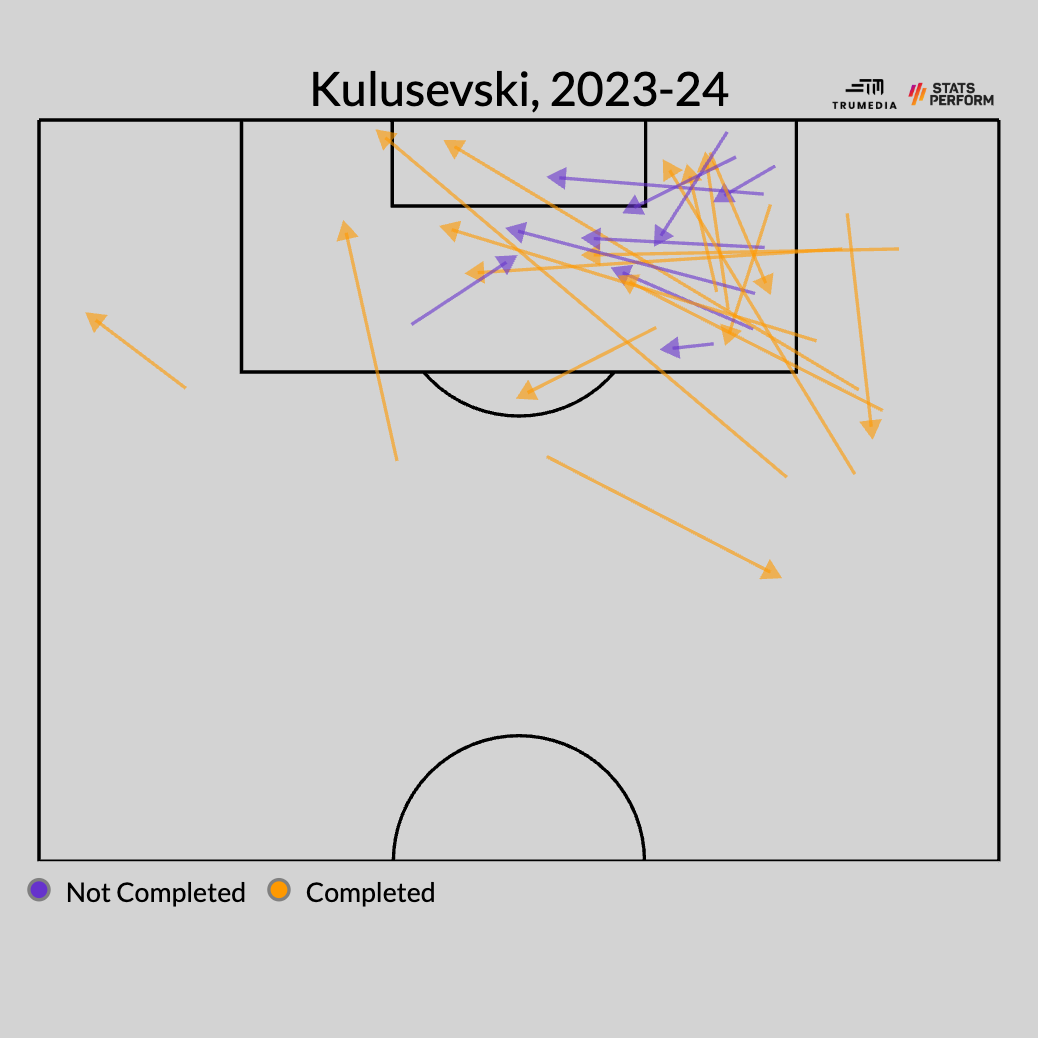
This graphic — showing all of his passes worth 5% of EPV or more — confirms my suspicions.
 WOLVERHAMPTON WANDERERS: Pedro Neto
WOLVERHAMPTON WANDERERS: Pedro Neto
– Position: winger
– Age: 23
– EPV: 2.54
Unlike James Maddison, Pedro Neto got injured in late October and still maintained his place on this list. (Wolves forward Matheus Cunha isn’t far behind, at 2.41.) Also, despite being injured in late October, Neto is still tied for the Premier League lead in assists with Trippier at seven.
Now, Neto’s passing numbers don’t support that gaudy assist total. He has generated 2.7 expected assisted goals, which just means his teammates have been especially hot when attempting shots from the passes he has played. However, that number still leads Wolves, as do Neto’s totals for passes into the penalty area and carries into the penalty area.
Although the Portuguese winger burst onto the scene three years ago with an impressive debut season and then just kind of disappeared due to injury problems for two straight seasons, he’s still only 23. Before getting hurt this year, he showed that, when healthy, he could probably contribute effective minutes at a much bigger club.
 NOTTINGHAM FOREST: Morgan Gibbs-White
NOTTINGHAM FOREST: Morgan Gibbs-White
– Position: attacking midfielder
– Age: 23
– EPV: 2.24
For Forest this season, Gibbs-White is doing what I like to call “the Eden Hazard.”
He’s leading the team in progressive passes with 52 and leading the team in progressive passes received with 84. In other words, he’s Forest’s starting quarterback and their starting receiver. If we wanna extend this metaphor nearly to its breaking point, he’s also their second-string running back, as his 35 progressive carries are second to only Anthony Elanga.
Gibbs-White isn’t scoring or creating all that much — zero non-penalty goals, two assists — but without him, Forest would struggle to ever get the ball near the other team’s goal.
 LUTON TOWN: Chiedozie Ogbene
LUTON TOWN: Chiedozie Ogbene
– Position: winger
– Age: 26
– EPV: 2.20
Along with their fellow promoted sides, Luton are one of the worst Premier League teams in recent memory. Ogbene, though, is just about their only means of ever hoping to move the ball forward. He has played about 900 minutes, yet he has more than double the number of progressive carries, carries into the final third and carries into the penalty area of any of his teammates.
 CRYSTAL PALACE: Joachim Andersen
CRYSTAL PALACE: Joachim Andersen
– Position: center back
– Age: 27
– EPV: 2.09
Without set pieces, Eze would be only third among Palace players, so instead we’re going to focus on the guy who is first from open play.
Eze fits the mold of many players on this list, electric dribblers who can slip passes into dangerous areas, and: guys who take set pieces. However, Palace’s leader in open-play EPV created has nothing in common with anyone on this list so far. That’s because it’s Joachim Andersen, the 27-year-old, 6-foot-3 Danish center back.
More so than even your standard midfielder, Andersen has to generate his value by completing a ton of low-value actions. So for his graphic, let’s drop the threshold down to passes that increased Palace’s chances of scoring by at least 0.5%:
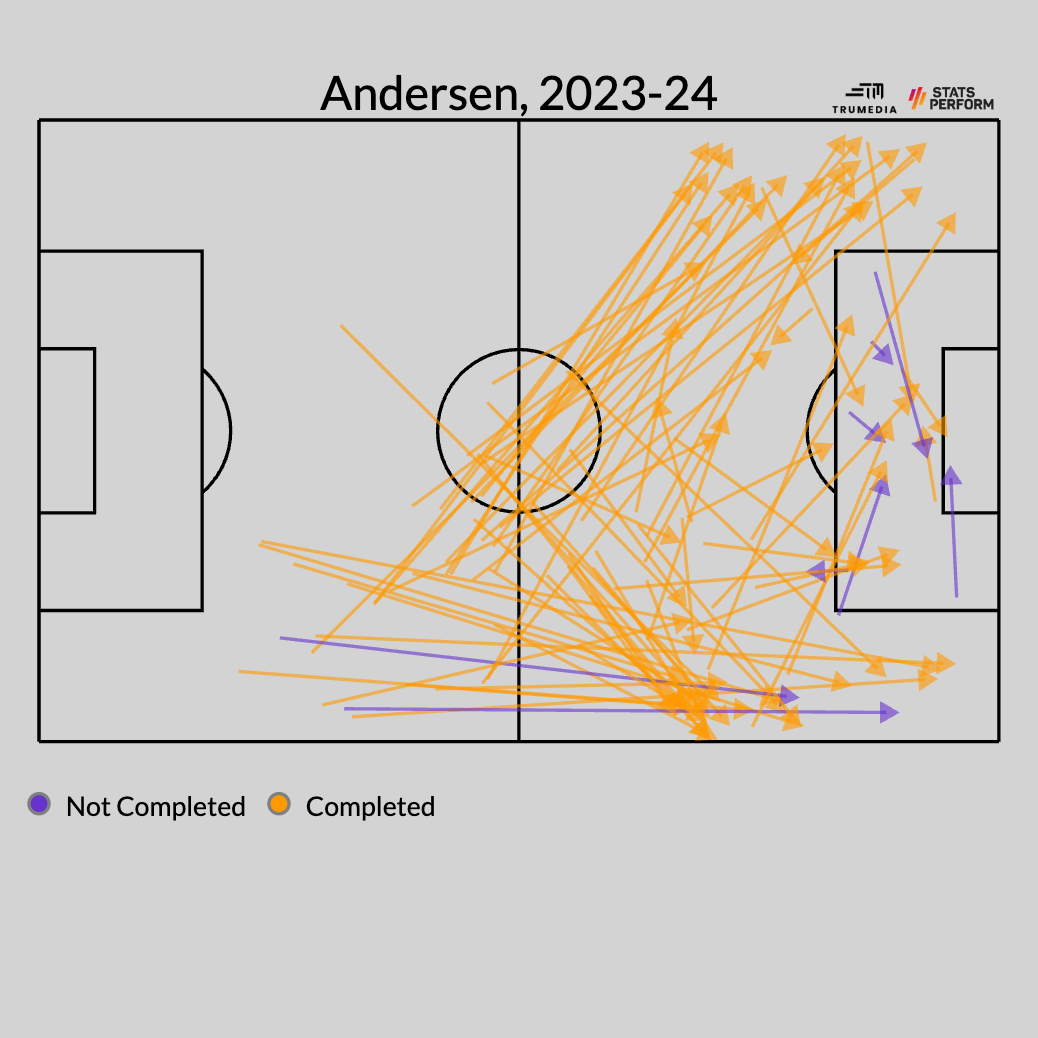
Those long diagonals aren’t worth a ton, but they’re still more valuable than almost any other pass a center back can make.
 FULHAM: Antonee Robinson
FULHAM: Antonee Robinson
– Position: fullback
– Age: 26
– EPV: 1.92
How’s this for an approximation? The average diagonal from a center back is roughly worth about the same as the average intercepted pass. Robinson leads the Premier League with 38 interceptions this season, 13 more than anyone else. All in all, they’ve added 0.19 EPV, or 0.5% of goal-scoring probability per interception.
Against Liverpool on Sunday, Robinson added more EPV than any other Fulham player: 0.28. Some of the highlights:
-
From passes: 0.13
-
From interceptions: 0.06
-
From blocked passes: 0.06
-
From attempted take-ons: minus-0.03
Robinson intercepted 13(!) passes against Liverpool, more than double the tally of any other player in any Premier League game this season. And despite that freakish effort, those actions just increased Fulham’s probability of scoring a goal by 6%, combined. As these models view the game, everything that happens in and around the box is so much more important than everything else.
 BURNLEY: Zeki Amdouni
BURNLEY: Zeki Amdouni
– Position: forward
– Age: 23
– EPV: 1.86
Theory: It’s a bad sign that Burnley’s leader in EPV generated is their center-forward. These players are supposed to be the ones who capitalize on all the possession value generated by their teammates, not the other way around. Of course, false 9s do exist, but Amdouni, who is a really interesting player in a vacuum, being on this list is a symptom of Burnley’s larger issue. That is: they don’t have the quality of players they need to play the way they’re playing.
Can you afford the goal-scoring winger types who have defined the past decade of the sport? Sure! Turn your center-forward into a facilitator for them.
Are you a team that was just promoted from the Championship? Maybe just try to find a guy who can score some goals. Amdouni has two in 13 starts.
 EVERTON: James Tarkowski
EVERTON: James Tarkowski
– Position: center back
– Age: 31
– EPV: 1.82
This is my favorite one. Despite their current 10-point-penalty-induced place in the relegation zone, Everton have been a legitimately above-average Premier League team this season. And given that there’s barely been any money to invest in improving the team’s personnel, I think we have to give Sean Dyche a ton of the credit for how they’ve been playing.
Without any great creative passers or even any top-level ball carriers on the team, one of their main methods of dangerous ball progression comes from Tarkowski’s long balls right up the gut. Unlike Andersen’s diagonals, Tarkowski’s valuable passes are angled toward much more dangerous areas — frequently to Dominic Calvert-Lewin peeling off the back shoulder of a defender in the channel. These are all of the 31-year-old’s passes that increased Everton’s chances of scoring by at least 1%:

Some of these passes are classic, quick, counter-attack-springing long balls. But a bunch of them also come from periods where Everton generates settled possession and cycles the ball around the back and then Tarkowski tries to catch the defense sleeping with a quick ball over the top. Dyche seems to be encouraging these risky passes because he knows that even if they’re not completed directly, Everton could win the second ball or press high and create a turnover near the opposition penalty area.
Even if the points deduction sticks, they should be able to cruise to safety.
 BOURNEMOUTH: Philip Billing
BOURNEMOUTH: Philip Billing
– Position: central midfielder
– Age: 27
– EPV: 1.56
He’s the Danish Marouane Fellaini — a gigantic midfielder who can’t really pass but is so physical and rangy that he’s able to get himself into advanced positions where he can still move the ball to better-positioned teammates despite a lack of vision and high-level technical skill.
One fun fact about Billing that also might shine a tiny light on how passing works. Last year, he averaged a 77.1 pass-completion percentage, which is very low for a midfielder. This year, under a completely new manager with a completely new system, Billing is averaging … a 77.1 pass-completion percentage.
 SHEFFIELD UNITED: Oliver Norwood
SHEFFIELD UNITED: Oliver Norwood
– Position: central midfielder
– Age: 32
– EPV: 1.54
Back in 2019-20, Norwood was really impressive for Sheffield United. Despite playing on a just-promoted team, he completed a ton of passes and moved the ball forward really well. Norwood’s performance in midfield felt like a big driver of the team’s ninth-place finish that year. It also felt like lightning in a bottle. He was 29 at the time and was such an integral player behind how it all worked; they either needed to find a replacement or a new way to play.
Three years and one pandemic later, Norwood is still Sheffield United’s most important player in possession. They’ve been relegated once already, and this year? They’ve got a shot at going down as the worst Premier League team of all time.
